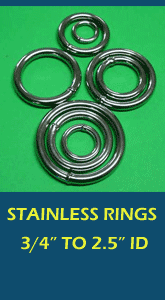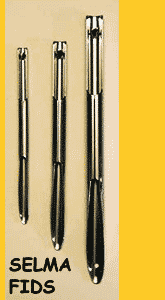One of my favorite boating activities is anchoring. I enjoy visiting a new anchorage, relearning an old anchorage and just watching the day evolve from first light to last light while anchored. Over almost three decades I have, ever so slowly, moved my 1969 Camper & Nicholson 32 from Greece to Florida.
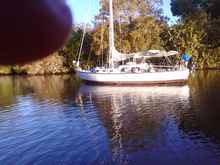 |
My old CNN 32 with two anchors in the canal and a line to a tree on the bank. The location is about 1/8 mile from the Indiantown, Flordia marina. |
I have spent periods in Marinas but when I am out in a canal, river or bay on my own anchors how my spirits rise. I can hear the birds, I can hear little waves breaking and I have a nice cool breeze blowing through the boat. Best of all this breeze does not contain any of the horrible dust coming from my marina friends redoing their boats bottoms.
Over these past three decades I have spent several thousand nights at anchor. As each of these nights end I enjoy the sunrise with my hot chocolate and look over the anchorage for old friends to get reacquired with and new friends to get acquainted with.
What follows is my beliefs on how to anchor a small sailboat so thousands of nights will go without a horrible incident. In every anchorage there are strong winter gales, strong summer squalls and other happenings that require the anchor outer to buy heavier anchors, and longer chain and rode. What follows is how my thinking and gear has changed over this long time period.
Anchor Winch
I basically used one book to set up my boat in 1980 After 50,000 Miles by Hal Roth.
I purchased a Simpson & Lawrence 555 anchor winch after reading this book. If I had to it over again I would look for a winch that has less dissimilar metals something like the long out of production Simpson & Lawrence 500. I rarely use the low speed on the 555. I just wait for the boat to move up on the rode or chain and take up the slack.
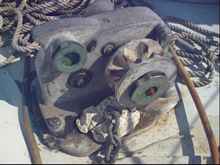 |
A photo of my 555. The winch has a 3/8 BBB chain gypsy on the right and a rope drum on the left. The winch has two speeds and has an aluminum case, a cast iron chain gypsy, an aluminum rope drum and many stainless steel parts. |
Twenty year ago I returned to the boat after the boat had been in storage for two years and found the winch frozen. I removed the winch and tried to disassemble it but no joy the stainless bolts were frozen in the aluminum case. Some body said all outboard motor repair shops were very good at disassembling and freeing up the insides and reassembly of aluminum cases (i.e. outboard motors).This advice was spot on. I then walked to the nearest outboard motor shop carrying the winch, returned the next day, found the winch completely freed up. This shop advised me to half fill the case with front wheel bearing grease as they were sure gear oil would leak and the whole problem would repeat. I followed this advice and have had no water inside the case and no frozen gears since. I do wonder which decade I should open the winch case, clean out the old grease, refill and reseal. I am thinking of doing this in the next decade (ha ha). Little bits of the winch fall off from time to time. I replace them and continue on.
Two in the Water and One on Deck
I slowly adopted this mantra and now almost always have two anchors in the water and one on deck ready to run if needed. With just one anchor in the water the boat could be aground with a little incident like dragging, cut rode from coral or junk on the bottom or a power boat's propellers cutting the rode. With two in the water I should be able to come home and find the boat in place (almost) but one rode slack and cut.
In shallow water with lots of boat traffic, I now set the windward anchor, drop way back and drop the leeward anchor and then pull myself back so the ends of the two chains are 20 or 30 feet apart and on the bottom. Each chain is about 70 feet long. The water depth is often about 10 feet.
I am using a very high scope in order to stay in place if some kind of weather event occurs in the first few days. I usually do not go ashore for a day or two to allow the chain and anchors to settle into the silty bottom.
As the boat goes around and around it takes an hour or two every month or two to untangle the rodes (I believe this is a version of Bahamian Mooring). I no longer use the motor to 'set' the anchors. Instead I rely on the weight of the anchors and chain to settle into the bottom and subsequently be able to resist the fierce south Florida summer squalls and the winter cold fronts. In a much rarer hurricane I will have so many anchors and all that chain on the bottom as well as several ropes into the mangroves that the motor would serve no use. However, I do rely heavily on my old and much abused 8 foot hard dinkey to run and then pick up all that stuff.
When I do move after being in place for several months it will take at least 4 hours to recover and clean the chain, the anchors and the boat. It could take several days if something large and heavy has fouled an anchor.
With a big anchor on deck connected to my heaviest and longest chain and 200 feet of almost new 1/2 inch rode I might survive a horrible wind storm aligned with the longest fetch.
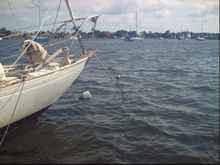 |
My two in the water rodes twisted after two months of the boat going around the same way. It should take less than an hour to remove the twists and re flake the rodes. The chain has no twist as the rode did all the twisting. Trying to use an anchor winch on a twisted chain is very difficult. |
Organizing the chain, anchors and rode on board
I suspect all boats collect anchors, chain and rodes opportunistically as time passes, but only organize these when something forces them. My time came during and between Hurricanes Jean, Frances and Wilma (2004 or 2005). I dug all this stuff out of various lockers and found I had 5 anchors but I did not have the chain, rode, thimbles and shackles to use all five anchors. So I had these long talks with myself "why do you want so many anchors?" and why are you using these old roads, and this old short, rusty and worn chain. So I replaced all the old stuff and now carry 5 complete and made up anchors, chain and rode. Since that time I am thinking about selling anchor #5 because it has never been used and removing it would lighten the boat by maybe 200 pounds. Some of the old stuff I have hidden near my secret hurricane anchorage.
My Current Anchors, chain and rode:
Anchor Selection
How do I select an anchor type and weight? I think mostly from reading and talking to other anchor outers. I meet people, every year, who have read the recommendations on the plastic bag their anchor came in saying a 34 foot boat should use a 12 lb. anchor on 6 feet of 1/4 inch chain with 30 feet of rode. Each year I watch a boat owner with too little anchor try and try to get anchored and not succeed. I sometimes see his wife holding his anchor, on the bow, waiting for his command to drop it. I see him back down and keep going. Sometimes they finally give up and go to a marina.
And just once I spoke to a sailboat, about 35 feet long, that just spent a year at the tip of South America with 105 lb. CQR's saying they worked fine. Once while aground I found I could pull as hard as I could with a 22 lb. Danforth on 100 feet of 5/16 chain and 300 feet of 1/2 inch rode and a few days later over a hard scoured bottom I could not get hooked up with my 45 lb. CQR on 170 feet of 3/8 chain. So either a 22 or a 45 on a medium length of chain say at least 70 feet in about 20 feet of water will work. If I ever go to the Pacific and try to anchor in 80 feet of water I will be a "Learner" all over again.
CHAIN PIPE AND HAUSE HOLE
To install my anchor winch I made up a teak plate about an inch thick and a few inches bigger than the winch. Since the deck was crowned I carved the teak plate until it laid flat on the deck. I then used the holes on the winch to drill through the teak plate and the deck to fasten the winch in place I used 1/2 inch bolts with a 1/4 inch thick Aluminum backing plates to spread the load to the deck. The winch had a hole to pass the chain but this hole was too small to allow the thimble and shackle for a rope rode to pass through the deck. One day I got fed up with this restriction and removed the winch and sawed off the part of the winch base containing this hole. I reinstalled the winch and used it as a template to saw a large hole through the deck. This hole was a little bit bigger than the 1/2 inch shackle and thimble. With this big hole I could keep a long rode under the 170 feet of chain in case I needed to anchor in deeper water or wanted to lay out all that chain plus some rode (like for Hurricane's Francis, Jean and Wilma). I found it a bit difficult to pass the transition between the rope and the chain over the winch and down the Hawse hole. I sometimes use rolling hitches to pull up enough chain to get the shackle passed the gypsy.
I ended up with a big hole in the deck. To fill this hole I used masking tape to hold the chain in place and plug the hole. I then used grease as mold release and filled the hole with epoxy mixed with some fiberglass fibers (for strength) and Cabosil to thicken the mix. To keep the mix from leaking past the tape I mixed enough to pour about a half inch in the hole. After this epoxy set I poured the rest. The next day I pulled the plug, sawed it apart and trimmed it with my mini grinder using a 24 grit disk.
Now I could keep the anchor and some chain on deck ("one on deck") and ready to go and also keep the rain out. Later I cast a solid plug to use on crossings. These plugs fit fairly well and do a good job of keep out water when well coated with grease.
The boat came with a "chain pipe". This caused nothing but grief always jamming when the chain piled got high enough to touch the chain pipe. I cut this pipe out. I now shift part of the forward bed and let the chain pile up as it likes and use a stick to knock it down after we are under way. If the chain is dirty the forepeak will smell bad for some days, so I try to wash the chain with a deck wash pump as I crank it in.
That's it, see you back in the mangroves if a Hurricane is coming or else out in the middle of the bay.
Fineto
|



